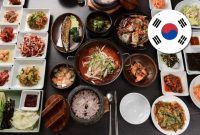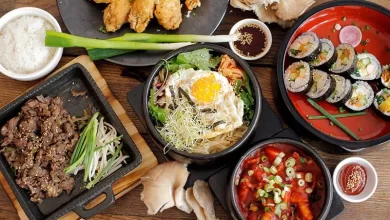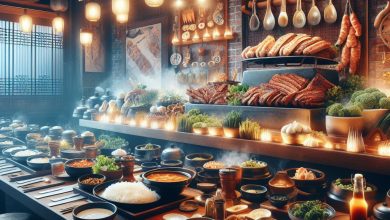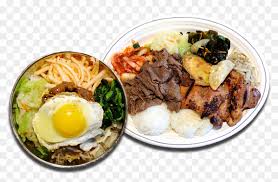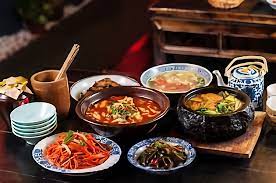What is Korea’s most popular food? What is the food culture of Korea?
Korea's most popular food
Korea’s most popular food:
Due to the vast range of personal preferences, it is challenging to choose a single “most popular” dish from South Korea’s rich and diverse culinary heritage. Nonetheless, a number of Korean delicacies are appreciated and acknowledged as national favorites across the nation. Here are few instances:
- Kimchi: Kimchi is an essential component of Korean cuisine, as was previously noted. Not only is it a side dish, but it’s a mealtime staple as well. Though there are many different types of kimchi, one of the most popular is baechu kimchi, or cabbage kimchi.
- Bibimbap: A bowl of steamed rice topped with a variety of seasoned vegetables, such as carrots, spinach, mushrooms, bean sprouts, and gochujang (hot red pepper paste), is known as bibimbap. It is a popular Korean cuisine. It can also have tofu or pork in it. Before eating, the ingredients are combined.
- Bulgogi: The main ingredient in bulgogi, a marinated and grilled meat dish, is usually thinly sliced beef or pork. Before grilling, the meat is marinated in a savory and sweet marinade, and it’s often served with rice and veggies.
- Kimchi Jjigae: A hot kimchi stew known as kimchi jjigae is prepared with tofu, kimchi, veggies, and frequently some kind of protein (seafood, beef, or pork). This is a famous Korean soup that is quite warming, especially during the winter months.
- Korean BBQ: Korean barbecue, also known as “gogi gui,” is a popular meal where customers cook their own meat at the table—usually chicken, hog, or beef. There are generally several side dishes and sauces available to go with the grilled meat.
- Tteokbokki: A common street dish in South Korea is tteokbokki. It is made out of chewy rice cakes that are fried in a sweet and sour sauce called gochujang. Boiled eggs and fish cakes are frequently served with it.
- Korean Fried Chicken (Chimaek): In South Korea, fried chicken has become quite popular, and it’s frequently consumed with beer, or “chimaek” (a combination of the words “chicken” and “maekju,” which means beer).
- Jjajangmyeon: Popular Korean-Chinese noodle dish jjajangmyeon is prepared with veggies, diced pork or other protein, and black bean sauce. In South Korea, this comfort dish is highly appreciated.
It’s vital to remember that South Korean food is dynamic and varied, offering a broad variety of meals to suit a variety of palates in addition to regional specialties. The cuisine that is deemed most popular might change based on the area and individual tastes.
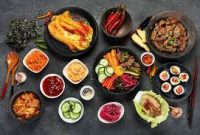
What is the food culture of Korea?
Korean cuisine has a long history and is firmly anchored in tradition. It is distinguished by a focus on using seasonal and fresh ingredients, a harmony of flavors and textures, and an assortment of side dishes that are served alongside rice. Key elements of Korean cuisine culture are as follows:
- Rice as a Staple: In Korea, a typical dinner frequently consists of a bowl of steaming white rice as rice is a staple dish there. The majority of Korean recipes are built around it, and meals are frequently referred to as “bap” (rice meals).
- Banchan (Side Dishes): Korean cuisine usually comes with a variety of banchan, or tiny side dishes. Various veggies, pickles, kimchi, and other seasoned foods may all be found in banchan. These side dishes provide the dinner a variety of tastes and textures.
- Fermented Foods: A big part of Korean cooking is fermentation. A well-known example is kimchi, which is produced from fermented vegetables like radishes and cabbage. Korean cookery also makes extensive use of red pepper paste (gochujang) and fermented soybean paste (doenjang).
- Balanced Flavors: A harmony of tastes, including sweet, salty, spicy, and savory, is emphasized in Korean cooking. Many foods have more complex flavors because of the usage of aromatic spices like garlic, ginger, and others.
- Table Settings: Metal chopsticks and a spoon are among the many tools that are frequently used to serve traditional Korean food. Everybody at the table has their own set of cutlery.
- Korean BBQ: “Gogi gui,” or Korean BBQ, is a popular eating experience in which guests cook their own meat at the table. Usually served with the meat is a selection of banchan and dipping sauces.
- Spice and Heat: Spicy ingredients are a common feature in Korean cuisine, usually derived from gochugaru (red chili flakes) or gochujang (red pepper paste). A characteristic of some of the most well-known Korean meals is their spicy flavor.
- Sharing and Community: Sharing dishes is normal and family-style dining is the norm for Korean dinners. This encourages a feeling of camaraderie and solidarity over meals.
- Celebration and Rituals: There are several customs and traditions associated with Korean cuisine. For a variety of events and festivities, including festivals, marriages, and ancestor ceremonies, special foods are made.
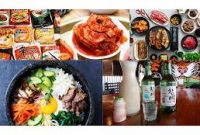
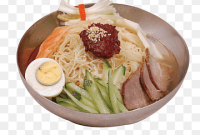
In recent years, Korean cuisine has become more and more famous worldwide, with foods like bulgogi, bibimbap, and kimchi gaining widespread notoriety. It is a cuisine that is praised for its wide range of tastes, nutritious ingredients, and the bonding experience that comes from eating meals together.
